GCSE Biology Topic 2 – Cells and control
1/90
Earn XP
Description and Tags
Topic 2 – Cells and control
Name | Mastery | Learn | Test | Matching | Spaced |
|---|
No study sessions yet.
91 Terms
What is the cell cycle?
The process cells undergo to grow, replicate DNA, and divide.

What are the three stages of the cell cycle?
Interphase
Mitosis
Cytokinesis
What happens during interphase?
Cell grows, duplicates DNA and organelles, preparing for division.
The cell spends most of its life in this phase
What is the result of mitosis?
Two genetically identical diploid daughter cells.
What is cytokinesis?
The final stage of cell division where the cytoplasm splits into two daughter cells.

What is mitosis?
A nuclear division resulting in two genetically identical diploid daughter cells, each with an identical set of chromosomes as the parent cell.
This results in the formation of cells that are genetically identical to each other and to the parent cell.
What is the diploid number in humans?
23 pairs of chromosomes (46 total).
Where does mitosis occur?
In all body cells except gametes (sex cells).
Functions of Mitosis
1. Growth – Produces new cells for an organism to grow.
2. Repair – Replaces damaged or dead cells.
3. Asexual reproduction – Produces genetically identical offspring in certain organisms.
What are the 4 stages of Mitosis?
Prophase
Metaphase
Anaphase
Telophase
What happens in Prophase?
o Chromosomes condense and become visible.
o Nuclear membrane breaks down.
What happens in Metaphase?
o Chromosomes line up along the middle of the cell.
What happens in Anaphase?
o Chromosomes and their copies are pulled to different ends of the cell.
What happened in Telophase?
New membranes form around the chromosomes at either end of the cell
Mitosis Diagram

What causes cancer?
Cancer is caused by uncontrolled cell growth and division (it begins to grow and divide uncontrollably). This can result in the formation of a tumour.
What is a tumour?
A group of cancerous cells
Types of Tumour
Benign Tumours and Malignant Tumours
What are Benign Tumours?
Grow in one area and are surrounded by a membrane.
Do not spread to other parts of the body.
Not considered cancerous and usually less dangerous.
What are Malignant Tumours?
Cancerous and invade neighbouring tissues.
Can spread to other parts of the body through the blood or lymphatic system, forming secondary tumours.
Dangerous because they disrupt the function of affected organs, which can be life-threatening.
Growth in Animals and Plants
What is Growth?
Growth is a permanent increase in size or mass due to the production of new cells.
How does Growth occur in Animals?
Cell Division and Differentiation
How does Growth occur in Plant ?
Cell Division, Elongation and Differentiation
Why Monitor Growth?
To identify potential health issues:
Malnutrition (underweight)
Obesity (overweight)
Inconsistencies in growth (e.g., a large body size with a small head)
Sudden changes in growth patterns, which may indicate an emerging health problem.
What is Cell Differentiation?
Cell differentiation is the process by which a cell changes to become specialised for a specific function.
What are Specialised Cells?
Specialised cells have structural adaptations which enable them to perform specific functions within the organism
Cell Differentiation in Animals
Most animal cells differentiate at an early stage of development.
In mature animals, cell division is mainly for repair and replacement.
Specialised animal cells usually lose the ability to differentiate once they are formed.
Adult stem cells can still differentiate to replace cells like blood or skin cells.
Cell Differentiation in Plants
Many plant cells can differentiate throughout the life of the plant.
This allows plants to keep growing and forming new specialised cells, even in mature stages.
What are Stem Cells?
A stem cell is an undifferentiated cell that can divide to produce more cells of the same type.
Stem cells can also differentiate to form other types of specialized cells.
Types of Animal Stem Cells
1. Embryonic Stem Cells
2. Adult Stem Cells
Where are Embryonic Stem Cells found?
Found in the early embryo
What can Embryonic Stem Cells differentiate into?
They can differentiate into any type of body cell.
Where are Adult Stem Cells found?
Found in tissues like bone marrow, skin, and the brain.
Embryonic stem cells are crucial for the development of all tissues and organs in the body.
What can Adult Stem Cells differentiate into?
They can only differentiate into a few cell types.
More limited than embryonic stem cells.
Mainly used for repair and replacement of damaged cells.
Where are plant cells found?
In plants, stem cells are found in meristem tissue located at the root and shoot tips.
What can plant cell differentiate into?
Meristem cells are unspecialised cells that can differentiate into any type of plant cell.
These cells are important for plant growth and development.
Key Features of Plant Stem Cells
Meristem cells remain undifferentiated throughout the life of the plant.
They can differentiate into any type of plant cell when needed, especially in regions where growth occurs.
Example of Differentiation in Plant Cells
Meristem cells in roots can become:
Root hair cells for absorbing water and minerals.
Xylem cells for transporting water.
Phloem cells for transporting sugars.
Uses of Plant Stem Cells
1. Plant Cloning – Meristem cells can be used to produce clones of plants with desired characteristics
Uses of Adult Stem Cells in Medicine
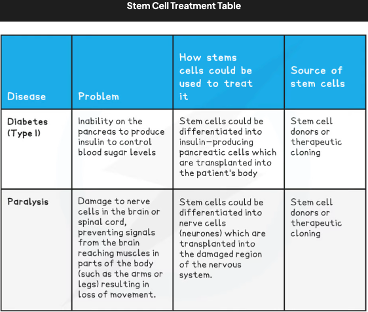

Benefits and Risks of Using Stem Cells
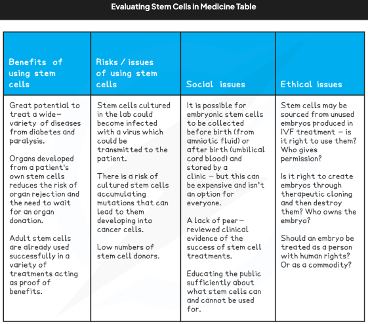

Co-ordination and Response
What are the two systems in the Nervous System?
o Central Nervous System (CNS): Brain and spinal cord.
o Peripheral Nervous System (PNS): All nerves in the body.
Q: What makes up the Central Nervous System (CNS)?
A: The CNS consists of the brain and spinal cord.
Q: What is the main role of the Central Nervous System (CNS)?
A: To coordinate the body’s response to stimuli by processing information and sending instructions to the rest of the body.
Q: How does the CNS work?
It receives information from sensory organs (e.g., eyes, ears, skin).
It processes the information to decide what to do
It sends instructions to effectors (muscles or glands) to carry out a response.
What are nerve cells?
Nerve cells are called neurones. They are adapted to carry electrical impulses from one place to another. A bundle of neurones is called a nerve.
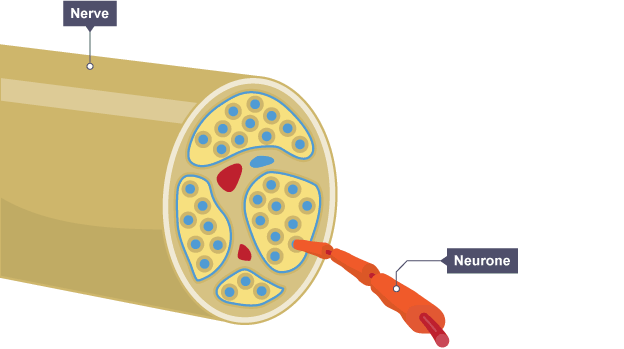
Structure of Neurones
Cell body: Contains the nucleus and main organelles.
Axon: A long, thin fibre that transmits impulses.
Dendrites: Extensions that connect to other neurones, forming a network for communication.
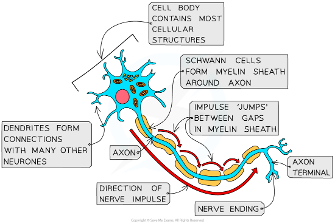
What are three main types of neurones
Sensory
Motor
Relay
1. Sensory Neurones:
o Carry impulses from sense organs to the CNS.
o Structure: Long axon with a cell body branching off the middle.

Relay Neurones:
o Found in the CNS, connecting sensory and motor neurones.
o Structure: Short with a small cell body at one end and many dendrites.

Motor Neurone
o Carry impulses from the CNS to effectors (muscles or glands).
o Structure: Long axon with a large cell body at one end and long dendrites.
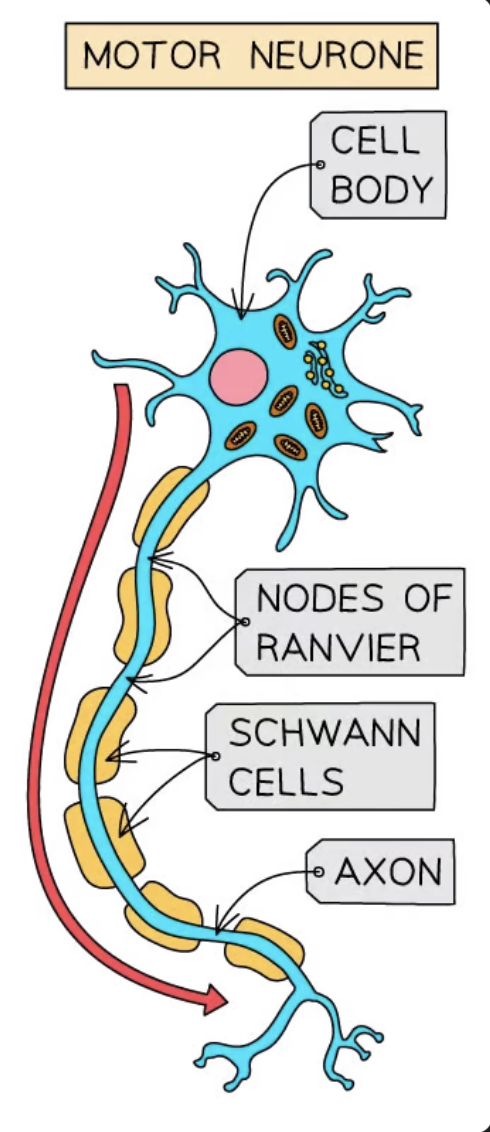
How to tell which neurone it is?
Sensory neurones are long and have a cell body branching off the middle of the axon
Relay neurones are short and have a small cell body at one end with many dendrites branching off it
Motor neurones are long and have a large cell body at one end with long dendrites branching off it
They have some features in common:
A long fibre (axon) which is insulated by a fatty (myelin) sheath. They are long so they can carry messages up and down the body.
Tiny branches (dendrons) which branch further as dendrites at each end. These receive incoming impulses from other neurones.

What is a synapse?
A synapse is the tiny gap between two neurones (nerve cells) where they pass signals from one to another.
What is the correct order for the Nervous System Pathway?
Stimulus → Sensory Neurone → Relay Neurone → Motor Neurone → Effector → Response
Q: What is a stimulus, and how is it detected?
A stimulus is a change in the environment, detected by sensory receptors (specialised to detect specific stimuli).
Q: What is the role of the sensory neurone?
A: It sends electrical impulses from the receptor to the CNS (central nervous system).
Q: What does the relay neurone do?
It transmits impulses within the CNS (brain or spinal cord), connecting sensory and motor neurones.
Q: What is the role of the motor neurone?
A: It carries impulses from the CNS to the effector (muscle or gland).
Q: What is an effector, and what does it do?
A: An effector is a muscle or gland that carries out the response (e.g., a muscle contracts or a gland secretes a hormone).
Q: Do neurones connect directly to each other?
A: No, neurones do not connect directly. They meet at a junction called a synapse.
Q: What is the small gap between two neurones at a synapse called?
A: The synaptic cleft.
Q: Can electrical impulses cross the synaptic cleft directly?
A: No, electrical impulses cannot cross the synaptic cleft directly.
Q: How is the electrical signal transmitted across the synapse?
A: The electrical signal is temporarily converted into a chemical signal carried by neurotransmitters.
Q: What do neurotransmitters do after crossing the synaptic cleft?
A: They bind to receptors on the next neurone, where the signal is converted back into an electrical impulse.
How an Impulse is Passed Across a Synapse
1. Impulse Arrival:
The electrical impulse travels along the axon of the first (presynaptic) neurone.
2. Release of Neurotransmitters:
o The impulse triggers vesicles at the end of the presynaptic neurone to release neurotransmitters.
o The vesicles fuse with the presynaptic membrane and release neurotransmitters into the synaptic cleft.
3. Neurotransmitter Diffusion:
o Neurotransmitters diffuse across the synaptic cleft.
o They bind to complementary receptors on the postsynaptic neurone’s membrane.
4. Generating a New Impulse:
o The binding of neurotransmitters stimulates the postsynaptic neurone to generate a new electrical impulse.
o This impulse travels down the second neurone.
5. Neurotransmitter Removal:
o Neurotransmitters are quickly broken down or removed to prevent continued stimulation of the second neurone, which would cause repeated impulses.
Q: What happens when an impulse arrives at a synapse?
A: The electrical impulse travels along the axon of the first (presynaptic) neurone.
Q: What does the impulse trigger in the presynaptic neurone?
A: It triggers vesicles to release neurotransmitters into the synaptic cleft.
Q: How do neurotransmitters reach the postsynaptic neurone?
A: They diffuse across the synaptic cleft and bind to complementary receptors on the postsynaptic membrane.
Q: What happens when neurotransmitters bind to receptors on the postsynaptic neurone?
A: It stimulates the postsynaptic neurone to generate a new electrical impulse.
Q: Why must neurotransmitters be removed after the impulse is passed?
A: To prevent continued stimulation and avoid repeated impulses.
Function of Synapses
Ensure impulses only travel in one direction (to avoid confusion in the nervous system).
Allow the nervous system to process and filter information.
Key Tips for Exam Questions
Neurotransmitters move by diffusion, which is passive and requires a concentration gradient.
Receptors on the postsynaptic neurone are complementary in shape to neurotransmitters.
Drugs (e.g., heroin, ecstasy, cocaine) can bind to neurotransmitter receptors, affecting brain activity by triggering or blocking impulses.
Q: What is a reflex response?
A: It is an involuntary response that does not involve the conscious brain.
Q: Why are reflex responses important?
A: They are automatic and rapid, helping to avoid injury and aid survival.
The Reflex Arc Pathway
The Reflex Arc Pathway
A reflex arc is the pathway taken by electrical impulses during a reflex response. Here's how it works using the example of a pain-withdrawal reflex (stepping on a pin):
1. Stimulus Detected:
o The pin (stimulus) is detected by a receptor (pain receptor) in the skin of the foot.
2. Sensory Neurone:
o The sensory neurone sends electrical impulses to the spinal cord (the coordinator).
3. Relay Neurone:
o An electrical impulse is passed to a relay neurone in the spinal cord.
o The relay neurone connects the sensory and motor neurones.
4. Motor Neurone:
o The motor neurone carries the impulse to the muscle in the leg (the effector).
5. Muscle Contraction:
o The muscle contracts and pulls the foot away from the sharp object (response).
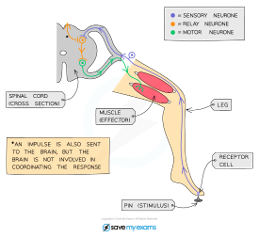
Q: What is a reflex arc?
A: It is the pathway taken by electrical impulses during a reflex response.
Q: What happens first in a reflex arc when you step on a pin?
A: The pin (stimulus) is detected by a pain receptor in the skin of the foot.
Q: What does the sensory neurone do in the reflex arc?
A: It sends electrical impulses to the spinal cord (the coordinator).
Q: What is the role of the relay neurone in the spinal cord?
A: It passes the impulse from the sensory neurone to the motor neurone.
Q: What does the motor neurone do in the reflex arc?
A: It carries the impulse to the muscle in the leg (the effector).
Q: What happens when the motor neurone stimulates the muscle?
A: The muscle contracts, pulling the foot away from the sharp object (response).
Q: Why are reflexes important?
A: Reflexes are rapid and automatic to protect the body from harm.
Q: Does the conscious brain get involved during a reflex response?
A: No, the response happens without conscious brain involvement; awareness comes after.
Q: What is the first step in the pain-withdrawal reflex?
A: The stimulus (pain) is detected by a pain receptor in the skin.
Q: What does the sensory neurone do in the pain-withdrawal reflex?
A: It sends electrical impulses to the spinal cord (CNS).
Q: What happens in the spinal cord during the pain-withdrawal reflex?
A: The impulse passes to a relay neurone, which connects the sensory and motor neurones.
Q: What role does the motor neurone play in this reflex?
A: It carries impulses to the muscle (effector) in the leg.
Q: What is the response in the pain-withdrawal reflex?
A: The muscle contracts and pulls the foot away from the sharp object.
Q: Why is the pain-withdrawal reflex important?
A: It’s an automatic, rapid response that protects the body from harm.